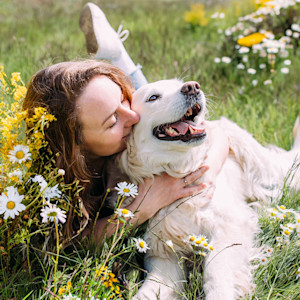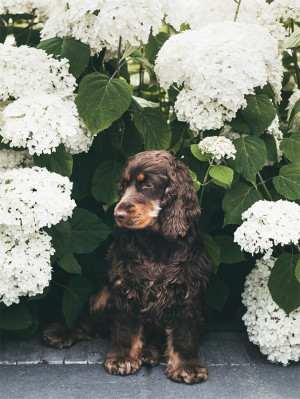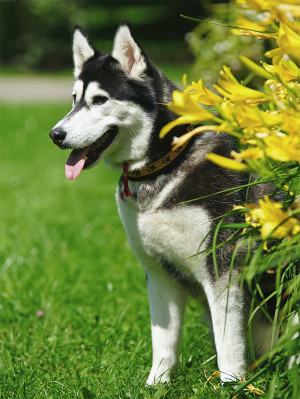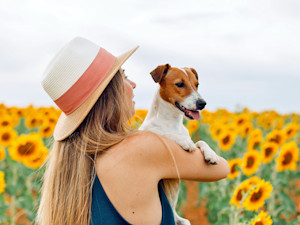Are Petunias Toxic to My Dog?
This is a go-to flower for many gardeners—but what about their dogs?

Share Article
Petunias are generally not considered toxic to dogs, making them a good choice for a pup-friendly garden. They are favorites among both experienced gardeners and novices because their beautiful flowers come in a variety of colors and they are fairly low- maintenance. They can be grown in pots or planted directly into the garden.
There are endless varieties of petunias, with the most common known as the common garden petunia, or Petunia atkinsiana. Even though they are considered non-toxic, it is important to remember that eating too much of any plant has the potential to make your dog sick, and there may be other, more unusual species of petunias that are not as safe. Read on to learn all about petunias and dogs.

littleKin™ is Kinship’s home just for puppy and kitten parents. Bop over to check out expert advice, new pet tools, and special deals—all curated for your newest family member.
opens in a new tabWhy are petunias dangerous to dogs?
In general, petunias are not considered dangerous to dogs. They do not contain toxic compounds like some plantsopens in a new tab that can cause serious illness or contact injuries. If your dog were to take a small lick or bite of a petunia, they would be fine.
However, if your dog were to eat a large amount of the plant, they could still be at risk for digestive upset like vomiting, diarrhea, or gas. This is because all plants contain a large amount of fibrous, indigestible material including cellulose and lignin.
Also, in the process of devouring the plant, your dog may ingest a large amount of soil, or other indigestible items. If your dog is really chowing down on your petunias, or any other non-toxic plants in your garden, you should still try to redirect them to another activity.
What should I do if my dog has eaten petunias?
If your dog has ingested a small amount of petunia, there is no cause for concern as this is a non-toxic plant for dogs. It is always important to accurately identify the plants they have eaten, however, as sometimes multiple plants may look similar but have very different toxic properties. Be sure you know what plant your dog ate so you can act accordingly.
If your dog ingested a very large amount of plant material, they may develop digestive upset, even if the plant is not toxic. It is important to monitor them for any signs of serious illness and seek veterinary care right away if they seem especially sick. Sometimes seeing your dog eat a plant seems to coincide with the start of their illness but that may simply be a coincidence and their symptoms may be related to something else entirely. Always address any health concerns right away with your vet.
Diagnosing plant poisoning in dogs
Typically plant poisoning is diagnosed based on a known history of a dog eating a specific plant. Many times a veterinarian cannot identify a specific plant poisoning based only on a dog’s symptoms as there are many different toxins that could cause similar patterns of illness. Therefore, if you see your dog eating a specific plant, it is very important to report that to your vet and, if you do not know its name, bring in a piece of the plant or a photo to help determine its identity. There are also pet poison hotlines that can help you determine if a plant is toxic to your dog. If in doubt, try to gather as much information as possible and contact your vet.
Symptoms of plant poisoning in dogs
Symptoms of plant poisoning vary greatly depending on what kind of plant your dog ate and what kind of toxic compounds it contains. Some common signs you might see include:
Vomiting: Digestive upset including vomitingopens in a new tab and diarrhea are some of the most common signs of plant ingestion. This can be due to specific compounds in the plant that irritate the digestive tract, or can simply be the result of eating too much plant fiber. If your dog is vomiting repeatedly, has no appetite, has blood in their vomit, or appears very weak or lethargic, these are all reasons to seek veterinary care right away.
Diarrhea: Diarrhea can also be a sign of digestive upsetopens in a new tab from eating too much plant matter, the result of toxic compounds in the plant, or due to intestinal parasites that may be present in the soil (if they also consumed soil).
Drooling: Drooling can be the result of nausea, pain, or specific toxic compounds in the plant that affect the nervous system.
Tremors: Tremors are often the result of toxins that affect the nervous system; however, tremors can also occur in dogs that are painful and just generally feeling ill. Tremors should always be checked out by a vet right away as they can worsen and develop into more serious neurological signs.
Pain: Pain is a nonspecific finding that can occur for many reasons. Dogs may show painopens in a new tab in ways that are different from us, including avoiding interaction, not eating, hiding, or yelping when lifted or touched. Some dogs may also growl or bite if they are in extreme pain. Pain may be the result of cramping in their digestive tract, or specific irritants in the plant that can cause contact injuries.
Irritation, blisters, or ulcers on their mouth or skin: Some plants contain oils and compounds that cause contact injuries. This means that when those oils come into contact with the skin or delicate tissues of the digestive tract, they can cause burn-like injuries, blisters, or ulcers. These can be very painful and may also cause drooling or a loss of appetite.
Difficulty breathing: Some plants contain more serious toxins that can lead to difficulty breathing or death. Any dog with difficulty breathingopens in a new tab needs to be examined by a vet right away.
Treatment
Treatment for plant toxicities will depend on the specific plant ingested, the kinds of toxins it contains, and the signs a dog is experiencing. For a nontoxic plant like petunias that may cause mild digestive upset, treatment would include supportive care to reduce nausea or pain related to digestive upset and to improve hydration.
For more serious toxic plants, treatment may require more aggressive interventions including hospitalization and intensive care. Sometimes, pet parents are not sure what, or if, their dog ate a specific toxin, so veterinarians need to treat for the signs present and based on the most likely diagnosis.
How to prevent plant poisoning
Prevention is the best way to prevent a serious toxin ingestion. Whenever possible, it is best to keep the most toxic plantsopens in a new tab out of your home and garden entirely. If you are not on your home turf and encounter new plants that you are not familiar with, be sure to keep your dog from eating them. Some helpful ways to do so include keeping your dog on the leash so they can’t wander too far, using redirection to bring their attention to safer things, or training your dog to wear a basket muzzleopens in a new tab if they have a history of repeatedly eating things that are not safe.
Are all parts of petunias safe for dogs to eat?
All parts of the common garden petunia are safe for dogs to eat in small amounts. However, any plant can cause digestive upset if a dog eats a large amount of it. It is also important to keep in mind that there may be other things around the plant that are not safe for your dog to eat including soil, mulch, other plants, pesticidesopens in a new tab, or plastic such as the plant markers or pieces of the planter. Be sure your dog is not also ingesting these materials, which may carry a very different set of risks.
How do I stop my dog from eating petunias?
If your dog is chomping your petunias on the regular, you may have to implement some strategiesopens in a new tab to keep both your plants and your pup safe. One of the easiest methods is to use a barrieropens in a new tab, such as a fence or gate, to keep your dog out of your garden. If you have plants indoors, you can try to place them in rooms where you can close the door and keep your dog out when unsupervised.
There are also helpful training strategies you can work on with your pup such as the leave it cueopens in a new tab, and redirection, to teach them what you want and expect. For dogs that are constantly fixated on eating plants, you may need to walk them on-leashopens in a new tab only to keep them away from your plants or use a basket muzzle to prevent them from ingesting dangerous items on walks.
The bottom line: Are petunias poisonous for my dog?
Luckily, petunias are not poisonous to dogs and you don’t need to panic if your pup samples a few. However, if your dog were to eat a lot of petunias, they may still suffer from digestive upset. You’ll want to try to discourage them from eating large amounts of any kind of plant matter.
It is also important to keep in mind that a lot of plants can look similar but have very different toxic properties, so if you are not sure what else may be growing in the area, it is safest to prevent your pup from eating the plants. Finally, any signs of illness should be checked out by a vet; even if you think you know what your dog ate and it doesn’t seem toxic, their signs of illness could be due to a completely unrelated issue. You don’t want to wait too long to seek help if your dog is acting sick for any reason.
Other plants that are safe for dogs
These houseplantsopens in a new tab are all safe to keep around dogs.
Spider plants plus these othersopens in a new tab are all safe for dogs too.
Orchids are also pet-friendlyopens in a new tab and beautiful.
Other plants that are dangerous for dogs
Peace liliesopens in a new tab are considered toxic to dogs.
Foxtails are not exactly toxicopens in a new tab but they can cause injuries to dogs who come into contact with them.
Sago palms and these other plantsopens in a new tab are also toxic to dogs.
References

Dr. Amy Fox, DVM
Amy Fox, DVM is a small animal veterinarian in New York City. A lifelong animal lover, Dr. Fox studied biology in college and then worked as a veterinary nurse before pursuing veterinary school at Cornell University. She has worked in many different settings including shelter medicine, emergency medicine, general practice, and animal cruelty and forensics. She is especially interested in nutrition, preventative medicine and care for senior pets. Dr. Fox also enjoys writing about veterinary medicine and teaching. In her free time she loves to cook, garden, and go for long runs.
Related articles
- opens in a new tab
Are Hydrangeas Toxic to My Dog?
You can live your best New England cottage life. Just keep your dog away from this plant.
- opens in a new tab
Are Lilies Toxic to My Dog?
This is one of those “no, but also yes” answers. Read on.
![woman hugging dog in field of daisies]() opens in a new tab
opens in a new tabAre Daisies Toxic to My Dog?
- opens in a new tab
Are Snake Plants Toxic to My Dog?
Just get a new dog? Might be time to find a new home for your snake plant.
![woman holding dog among sunflowers]() opens in a new tab
opens in a new tabAre Sunflowers Toxic to Dogs?
They are the best part of late summer. Can your pup take a sniff?
- opens in a new tab
Can Dogs Take Tylenol?
The short answer is no. Here’s why.
- opens in a new tab
Are Hibiscus Plants Toxic to Your Dog?
They’re bright and pretty—just like your pup. But are they safe?
- opens in a new tab
Can Dogs Eat Lemons?
The better question is if they like them.
![Staffordshire bull terrier dog eating grass]() opens in a new tab
opens in a new tab15 Things You Think Are Toxic for Dogs — But Actually Aren’t
From (human) prescription meds to poinsettia plants, these "toxic" items may not be so bad for your pup.
![Dog sitting on a couch in a living room with plants]() opens in a new tab
opens in a new tab5 Plants That Are Toxic to Your Dog
Thriving plants are spring’s whole thing—but these offenders can be perilous to pets.











